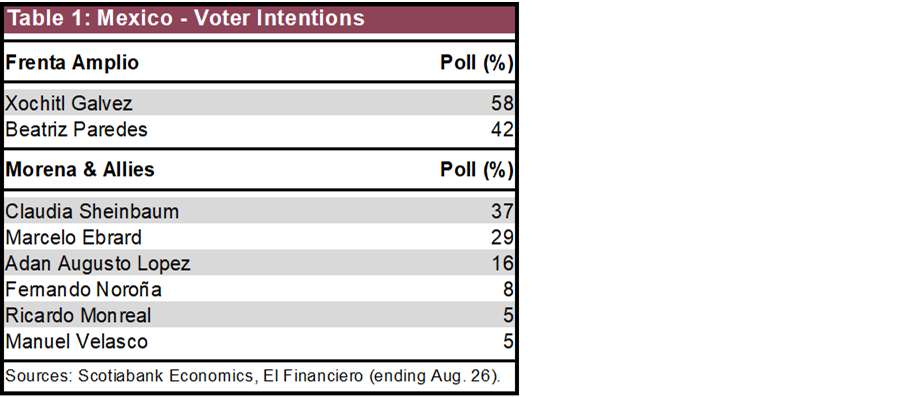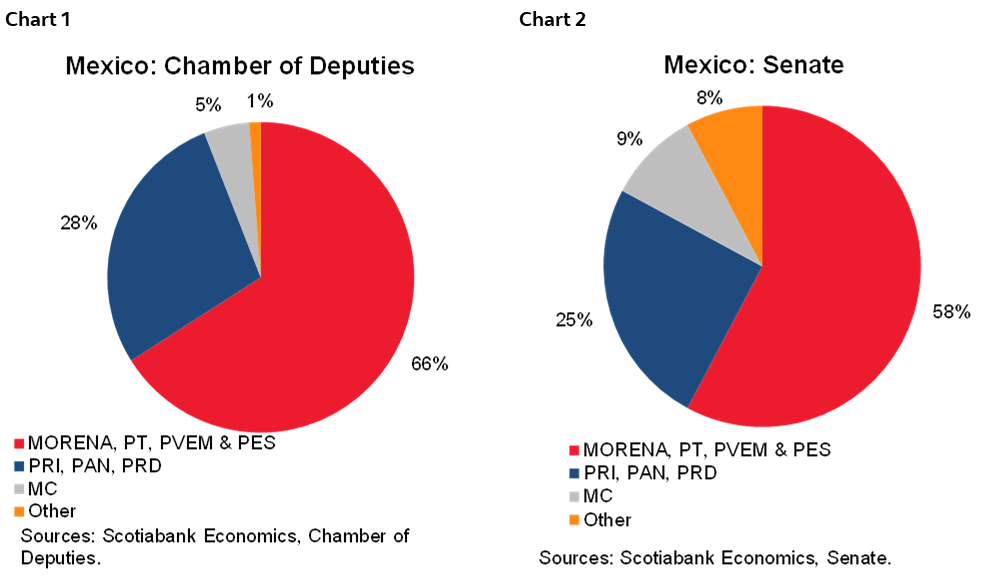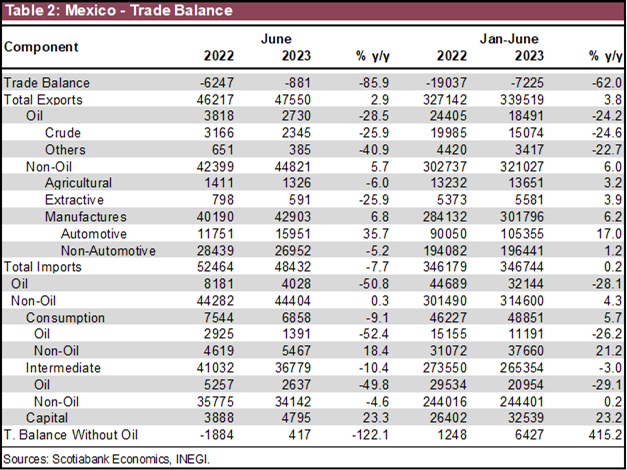- Mexico: Mexican chess pieces for 2024 presidential election will be broadly set over the coming 10 days; Mixed signs in trade data for July
MEXICO: MEXICAN CHESS PIECES FOR 2024 PRESIDENTIAL ELECTION WILL BE BROADLY SET OVER THE COMING 10 DAYS
What is at stake?
Mexico’s presidential election got an abnormally early start this time around, with the candidate selection processes for both the governing Morena coalition, and the PRI-PAN-PRD opposition coalition kicking-off almost a year before the 2024 vote. The actual elections will take place the first Sunday of June 2024 (June 2nd), yet by the end of the first week of September 2023, the candidates for both major contender blocks will be defined. The upcoming elections will define the presidency, 8 governorships, the Mexico City government, as well as both chambers of congress, consisting of 500 members of congress and 132 senate seats. Mexico’s electoral law states that the electoral process should not kick off until September 2023, pre-campaigns should not kick off until November 2023, and formal campaigns in 2024, which has led to some controversy over the anticipated ongoing process.
Who appear to be the contenders?
For the “Frente Amplio”, a coalition made up of the PRI-PAN-PRD and members of civil society, there are 2 remaining candidates: both former senators Xochitl Galvez and Beatriz Paredes. For Morena, the front-runners of the internal process at this stage appear to be Claudia Sheinbaum (former head of Mexico City’s government), Marcelo Ebrard (former Foreign Affairs Secretary), followed by Adan Augusto Lopez (former Interior Minister, table 1), but there are 3 other contenders vying for the nomination. The potential third contender, the MC party (which governs the key states of Nuevo Leon and Jalisco) has not yet announced how its candidate selection process will work, but its leader Dante Delgado has said it will not join another coalition. Many local political commentators believe the MC could end up supporting one of the two major coalitions. It’s worth noting that MC’s outgoing governor of Jalisco, Enrique Alfaro, has expressed displeasure with his party leadership, and has signaled he could join the Frente Amplio coalition.

How / when will we know the outcome?
The ruling Morena coalition is set to announce the results of its internal process on September 6th, with the results defined by the average of 5 polls (the average of one internally selected pollster and 4 external polls selected by raffle, but which external polls will be used has not been publicly disclosed). Morena’s polls will be conducted August 28th–September 3rd. For the Frente Amplio, the results will be announced on September 3rd, with the process having consisted of a series of debates and polls (which already narrowed down the contenders to 2), and a final exercise which will also include a direct vote.
Out of the 2 leading contenders for each of the 2 main camps, 3 are women, which suggests it is likely that Mexico will have its first female president starting December 2024, following June’s results.
What about Congress?
The Chamber of Deputies, consisting of 500 representatives—300 of them are elected by direct election and 200 more by the principle of proportional representation (how many votes each party obtained as a percentage of each of the 5 electoral regions)—is renewed every 3 years. On the other hand, the senate is renewed every 6 years and includes 128 legislators, of which 96 (three quarters) are elected by popular vote, and 32 indirectly by proportional representation. There is a small window of time that if Morena and its bloc were to obtain an absolute majority in the new congress, AMLO would have the chance of approving constitutional reforms. This period runs from September 1st, which is the date when the new congress will begin the legislative period—a 2014 electoral reform says that the new congress will start on August 1st, but we think current legislators will pass an amendment to avoid a political impasse as they were elected to serve until August 31st and October 1st, when whoever wins the presidential election will take office.
Is there a window for constitutional reforms?
In order for a constitutional reform to pass in congress, a majority of two-thirds is required in both the Chamber of Deputies and the Senate. With the current composition of congress, AMLO has not been able to approve some of the intended constitutional changes as he does not have the necessary votes (charts 1 and 2). Here is a simple breakdown of parties/blocs:

In the current Chamber of Deputies, AMLO’s bloc has an absolute majority (2/3 of the total), while in the Senate he has only a simple majority. This is enough to pass secondary reforms, but not enough to make constitutional changes. Within the opposition, we distinguish between the PAN-PRI-PRD and Movimiento Ciudadano party, since it seems— at least for now—that they will have different presidential candidates, and therefore different agendas in next year’s elections. We only highlight that part of the group of ‘others’ are opposition legislators who were formerly from the PAN, PRD, or PRI and have resigned from their parties.
Typically, in the last year of the administration, the president loses political power as his administration comes to end. However, as AMLO remains with a strong popularity, and at least two Morena possible candidates seem to follow a strategy of continuity of his politics, legislative negotiations could be linked to next year’s elections. Also, a small window could be set to try to pass constitutional legislation if the new congress favours his party.
—Eduardo Suárez
MIXED SIGNS IN TRADE DATA FOR JULY
In July the trade balance showed a $-881 million MXN, below the -2.2 bn consensus. Exports summed 47.55 USD bn in the month, growing 2.9% y/y. In detail, the increase was led by manufactures (6.8% y/y), and especially by auto exports that soared 35.7%. Oil exports plunged -28.5% y/y. In this sense, the appreciation of the Mexican peso could represent a problem for some exports, but not so much for auto makers since the sector is still normalizing in both the US and Mexican markets.
On the other hand, imports fell -7.7% y/y, The biggest drop came in the intermediate goods (-10.4 y/y), followed by a similar fall in the consumption goods (-9.1% y/y). Oil imports were also part of the decrease, as they dropped -28.1% y/y, as non-oil imports remain almost unchanged at 0.8% y/y. Non-oil consumption imports remain positive (18.4%) suggesting a still strong domestic demand. Also, the increase in capital imports somewhat supports the optimism regarding a stronger dynamism owing to nearshoring, despite the drop in intermediate goods.
In the year-to-date number, trade deficit summed -$7.225 bn USD dollars, as exports totaled 339.5 USD bn, and imports 346.7 USD bn, equivalent to a 3.8% and a 0.2% YTD increase, respectively. Looking ahead, we consider both exports and imports would remain moderately positive, despite restrictive policy rates, as consumption remain solid in both Mexico and its main trade partner, the US (table 2). Nearshoring phenomenon also play an important role in the positive outlook regarding trade numbers in the medium term.

Noteworthy, the trade deficit is not yet as strong as consensus expected, despite some views that the USDMXN could be somewhat overvalued. If that is the case, exporters could be facing lower revenues and profits, and consumers could be benefited by a higher purchase power and lower prices. In any case, the increase in both exports and imports suggest demand remains solid during the year.
—Miguel Saldaña
DISCLAIMER
This report has been prepared by Scotiabank Economics as a resource for the clients of Scotiabank. Opinions, estimates and projections contained herein are our own as of the date hereof and are subject to change without notice. The information and opinions contained herein have been compiled or arrived at from sources believed reliable but no representation or warranty, express or implied, is made as to their accuracy or completeness. Neither Scotiabank nor any of its officers, directors, partners, employees or affiliates accepts any liability whatsoever for any direct or consequential loss arising from any use of this report or its contents.
These reports are provided to you for informational purposes only. This report is not, and is not constructed as, an offer to sell or solicitation of any offer to buy any financial instrument, nor shall this report be construed as an opinion as to whether you should enter into any swap or trading strategy involving a swap or any other transaction. The information contained in this report is not intended to be, and does not constitute, a recommendation of a swap or trading strategy involving a swap within the meaning of U.S. Commodity Futures Trading Commission Regulation 23.434 and Appendix A thereto. This material is not intended to be individually tailored to your needs or characteristics and should not be viewed as a “call to action” or suggestion that you enter into a swap or trading strategy involving a swap or any other transaction. Scotiabank may engage in transactions in a manner inconsistent with the views discussed this report and may have positions, or be in the process of acquiring or disposing of positions, referred to in this report.
Scotiabank, its affiliates and any of their respective officers, directors and employees may from time to time take positions in currencies, act as managers, co-managers or underwriters of a public offering or act as principals or agents, deal in, own or act as market makers or advisors, brokers or commercial and/or investment bankers in relation to securities or related derivatives. As a result of these actions, Scotiabank may receive remuneration. All Scotiabank products and services are subject to the terms of applicable agreements and local regulations. Officers, directors and employees of Scotiabank and its affiliates may serve as directors of corporations.
Any securities discussed in this report may not be suitable for all investors. Scotiabank recommends that investors independently evaluate any issuer and security discussed in this report, and consult with any advisors they deem necessary prior to making any investment.
This report and all information, opinions and conclusions contained in it are protected by copyright. This information may not be reproduced without the prior express written consent of Scotiabank.
™ Trademark of The Bank of Nova Scotia. Used under license, where applicable.
Scotiabank, together with “Global Banking and Markets”, is a marketing name for the global corporate and investment banking and capital markets businesses of The Bank of Nova Scotia and certain of its affiliates in the countries where they operate, including; Scotiabank Europe plc; Scotiabank (Ireland) Designated Activity Company; Scotiabank Inverlat S.A., Institución de Banca Múltiple, Grupo Financiero Scotiabank Inverlat, Scotia Inverlat Casa de Bolsa, S.A. de C.V., Grupo Financiero Scotiabank Inverlat, Scotia Inverlat Derivados S.A. de C.V. – all members of the Scotiabank group and authorized users of the Scotiabank mark. The Bank of Nova Scotia is incorporated in Canada with limited liability and is authorised and regulated by the Office of the Superintendent of Financial Institutions Canada. The Bank of Nova Scotia is authorized by the UK Prudential Regulation Authority and is subject to regulation by the UK Financial Conduct Authority and limited regulation by the UK Prudential Regulation Authority. Details about the extent of The Bank of Nova Scotia's regulation by the UK Prudential Regulation Authority are available from us on request. Scotiabank Europe plc is authorized by the UK Prudential Regulation Authority and regulated by the UK Financial Conduct Authority and the UK Prudential Regulation Authority.
Scotiabank Inverlat, S.A., Scotia Inverlat Casa de Bolsa, S.A. de C.V, Grupo Financiero Scotiabank Inverlat, and Scotia Inverlat Derivados, S.A. de C.V., are each authorized and regulated by the Mexican financial authorities.
Not all products and services are offered in all jurisdictions. Services described are available in jurisdictions where permitted by law.

